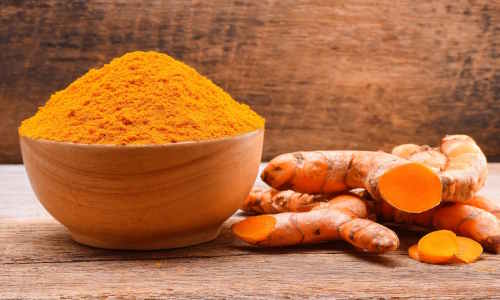What Are the Benefits of Turmeric?
Famed for purported anti-inflammatory and antioxidant properties, the botanical is hailed for helping a host of conditions. Is that true?
Have you noticed lattes, ice cream and smoothies with a tawny hue? That could be a sign of a not-so-secret ingredient: turmeric. The botanical is omnipresent in health food aisles, in the form of pills and powders.
Turmeric, native to South Asia, is one of the fastest-growing dietary supplements. In 2018 products racked up an estimated $328 million in sales in the United States, a more than sevenfold increase from a decade earlier, according to a report from Nutrition Business Journal.
Brightening up the pantries of many homes in India, the spice is interwoven into daily life, the cuisine, and cultural and healing traditions. A member of the ginger family, it has been used in Ayurvedic medicine for thousands of years. Apply turmeric to wounds, and it’s believed to fight infection. Mix it with milk, and the mind calms. Tint the entrance of new homes with a paste to welcome prosperity.
“Turmeric is auspicious and one of the most important herbs,” said Anupama Kizhakkeveettil, a board member of the National Ayurvedic Medical Association.
Sliced open, or dried into a spice, the Curcuma longa plant imparts its amber color and earthy, bitter flavor to food like curry. The active ingredient captured in many turmeric supplements is curcumin. Curcumin, along with the other curcuminoid compounds, compose only about 3 percent of the dried spice.
And bottles will often say turmeric on the front but list curcumin in the ingredients.
What do turmeric proponents claim as its benefits?
Turmeric is hailed for helping a host of conditions: high cholesterol, hay fever, depression, gingivitis, premenstrual syndrome and even hangovers. In Ayurvedic medicine, it is believed to act as an antiviral, antibacterial and antiparasitic, and has long been used to help with diabetes, pain, rheumatism, osteoarthritis, memory and skin conditions like eczema.
“We use it for so many different conditions, it’s a time-tested herb,” Dr. Kizhakkeveettil said. “Unfortunately, our science doesn’t fit into complete randomized controlled trials. That is alternative medicine’s biggest challenge.”
Does curcumin work?
A group of researchers sought to answer this by sifting through the available literature. In a 2017 paper in the Journal of Medicinal Chemistry, they concluded it’s fool’s gold. “There are claims that it can cure everything,” said Kathryn M. Nelson, a research assistant professor at the University of Minnesota and the study’s lead author. “To me, that is a red flag.”
Dr. Amit X. Garg, a professor of medicine at Western University in London, Ontario, knew about turmeric’s medicinal use because of his Indian heritage. He knew firsthand of its rich cultural significance too: On his wedding day, his relatives rubbed the spice all over him because it is believed to be cleansing.
After seeing the effectiveness of curcumin, in smaller studies, Dr. Garg and his colleagues decided to test it on a larger scale in hopes it would make elective aortic surgery safer by reducing the risk of complications, which include heart attacks, kidney injury and death. In the randomized clinical trial that followed, about half of the 606 patients were administered 2,000 milligrams of curcumin eight times over for four days, while the others were given a placebo. “It was a bit disappointing, but we couldn’t demonstrate any benefit used in this setting,” Dr. Garg said of the study, published last year in the Canadian Medical Association Journal.
In fact, there is not enough reliable evidence in humans to recommend turmeric or curcumin for any condition, according to the National Center for Complementary and Integrative Health. Turmeric became a nutritional golden child partly because of its promise in laboratory studies — cellular and animal. Some research indicates that both turmeric and curcumin, the active ingredient in turmeric supplements, have anti-inflammatory, antioxidant, antibacterial, antiviral and antiparasitic activity. But this has mostly been demonstrated in laboratory studies, and, in many cases, the benefits of preclinical research isn’t observed in clinical trials.
According to Natural Medicines, a database that provides monographs for dietary supplements, herbal medicines, and complementary and integrative therapies, while some clinical evidence shows that curcumin might be beneficial for depression, hay fever, hyperlipidemia, ulcerative colitis, osteoarthritis and nonalcoholic fatty liver disease, it’s still too early to recommend the compound for any of these conditions.
And Natural Medicines has found there isn’t enough good scientific evidence to rate turmeric or curcumin’s use for memory, diabetes, fatigue, rheumatoid arthritis, gingivitis, joint pain, PMS, eczema or hangovers.
Physicians say more research is needed. Dr. Gary W. Small, a professor of psychiatry and biobehavioral sciences at the David Geffen School of Medicine at the University of California, Los Angeles, who studies curcumin’s effect on memory, sees a lot of therapeutic potential. He also states that existing research demonstrates curcumin’s biological effects.
Do you know about the gift of nature to save the life of people from various health problems and make them feel secure by curing significant issues? How to live healthy in this world without having chronic diseases or illness or any other health issues which may hurt you physically and mentally? Due to dense population, people are trying to demolish the forest, garden areas to create shelter, so they forced to destroy the nature’s gift such as natural ingredients, secret medicinal herbs and more which are grown in wild forest, mountains and other places. When you read this review entirely, sure you will get chance to know about secrets medicinal ingredients, herbs and more used by our ancestor to get back the lost health without losing your life. Claude Davis was highlighted all the stuff in the form of the e-book The Home Doctor filled with a list of natural ingredients and remedies that you can quickly grow in the backyard or at free space to include it in your routine diet or external usage to get well soon.
Is there an optimum way for turmeric to be absorbed?
What may be affecting curcumin’s efficacy, doctors say, is that it is poorly absorbed from the gastrointestinal tract. In Indian cooking, turmeric is usually heated in a fat, like oil, which can increase absorption. Certain supplement manufacturers are also taking steps to improve this — curcumin’s bioavailability — by combining the compound with other components. For instance, a chemical found in black pepper — called piperine — is sometimes added to curcumin supplements in proprietary blends to increase its absorption.
Researching curcumin can be challenging because some blends have better bioavailability than others, and varying amounts of the active ingredient. “If you did the study over and over again but used slightly different preparations, you would probably have different results,” said Dr. Janet Funk, a professor of medicine at the University of Arizona College of Medicine-Tucson, who studies curcumin’s effect on bone.
Still, even if absorption improved, Dr. Nelson contends that curcumin would not have any biological effects. Turmeric may still have health benefits, she said, but they just may be from another compound or combination of compounds.
So is turmeric safe?
Consuming it by mouth is safe, up to 2 grams of turmeric daily for a year, and 4 grams daily of curcumin for a month, according to Natural Medicines. Turmeric aficionados who also use it as a face mask can relax too; the database indicates it is most likely safe to apply to the skin.
Doctors recommend that patients tell a physician they are taking turmeric. High doses of turmeric and its isolated constituents can have some rather unpleasant side effects, including diarrhea and nausea. Curcumin may also interact with anticoagulants and antiplatelets, antacids, and drugs used for chemotherapy and to control blood pressure. While the spice is considered safe in food, therapeutic doses should be avoided during pregnancy.
The Food and Drug Administration does not test dietary supplements like turmeric for safety and effectiveness but announced earlier this year that it would improve oversight of the growing industry.
One study published in 2018 in Molecular Nutrition & Food Research, found that the cheaper the turmeric product, the more likely it was to have chemical compounds suggestive of synthetic curcumin; and products with turmeric root were more likely to have higher lead levels. One sample exceeded recommended limits for lead.
How about all those turmeric lattes? Doctors do say that sprinkling a little bit of the bitter spice into frothed milk doesn’t have proven health benefits. But that doesn’t mean it isn’t delicious.
As for Dr. Garg, he is not closing the bottle cap on curcumin. To wit: He is in the middle of a randomized study with a different preparation and dosing to see if curcumin prevents the progression of kidney disease. “There are still many promising things about curcumin and turmeric,” he said. “I remain open-minded.”
Growing Turmeric – Planting, Harvesting, and Uses of Turmeric Roots
Don’t you just love curcumin? It’s got this iconic, bright yellow or orange color that makes it one of the most attractive spices in your cabinet. But there’s more to turmeric than its good looks!
Turmeric is a beautiful and tasty specie of the fresh ginger family. Resembling ginger in appearance, the roots and rhizomes of turmeric are used to spice food. While best known as a cooking ingredient and condiment, it goes beyond that. Golden in color, the roots and fresh rhizomes extract contains an active compound called curcumin.
Growing turmeric is a very simple process, requiring only basic green house gardening knowledge. The plant itself is quite resistant to pests and disease, making it ideal for beginners.
Growing turmeric is a very simple process, requiring only basic green house gardening knowledge. The plant itself is quite resistant to pests and disease, making it ideal for beginners.
Turmeric Varieties
There are over 100 varieties of this plant, which are closely related to ginger. The most common variety are White Mango turmeric, Black turmeric and Curcuma longa, or Indian turmeric, which produces a deep orange color. In addition to being a spice, the root has been used in cooking and medicine for thousands of years.
Yellow Turmeric (Curcuma xanthorrhiza)
The plant variety most commonly used for culinary purposes is Curcuma longa, also known as turmeric root or Indian saffron. This plant grows up to 6 feet tall and produces large leaves and yellow flowers. The roots are harvested after two years of cultivation and dried in the sun before being ground into powder or sold fresh at markets in Asian countries like India, where turmeric is an essential ingredient in many traditional Indian food such as curry and rice pilafs (pilav).
Curcuma Linn
This type of turmeric has large leaves that grow from the base of the plant. The leaves are usually removed before harvesting because they contain less curcumin than other parts of the plant. It has been used in Indian cooking for thousands of years due to its intense flavor and coloration properties.
Elephant’s Foot (Curcuma amada)
This variety produces large seed rhizomes and the leaves are green with purple-tinged veins. It grows best in tropical climates and does not tolerate freezing temperatures.
Haldi (Curcuma longa)
This variety originated in South Asia and was brought to Africa by Arab traders as early as 800 AD. It can be found in India, Africa, and South America where it is cultivated for its rhizomes which are harvested after four years of growth and dried for use as a spice or medicine. The plant has yellow flowers that bloom from June through September.
Tibetan turmeric (Curcuma domestica)
This variety is considered the most valuable because it has a high concentration of curcuminoids and essential oils. It also has the longest shelf life and can be stored for up to two years without losing potency.
Turmeric Powder (Curcuma aromatica)
This variety has darker colored roots than Kurkumawurzel, but it still has a strong aroma and bitter taste. It is typically used for coloring food products like curry powders and mustard, rather than as an herbal supplement.
Curcuma wenyujin
Curcuma wenyujin is native to southern China (Guangxi, Guangdong, Guangxi), northern Vietnam and Laos. It is an aromatic herb with a pungent odor.
The root is used as a spice to impart color to food and as a preservative, e.g., in pickles and cheese. The seed rhizomes indoors are also burned as incense in India, where they are known as kuṭaj or kuṭaja.
In Chinese medicine, it is used to treat indigestion, diarrhea, dysentery and fever; it also has anti-inflammatory properties. It is added to some varieties of Chinese dumplings, such as jiaozi and baozi and Japanese gyoza or Chinese wonton noodles.
Indonesian domestica
This variety has smaller rhizomes, which are usually harvested when they’re about 1 inch in diameter and 3 inches long. The rhizomes are then dried and ground into a powder for use as a spice or seasoning.
- Medicinal Garden
- With your seeds kit, you’ll also receive a FREE Medicinal Guide that shows you how to turn these 10 plants into tinctures, ointments, salves, poultices, decoctions, infusions, essential oils —all in minute detail so you can follow our guide even if you’ve never made an herbal medicine in your life.
How to Grow Fresh Turmeric Root: A Complete Guide
The root of this plant is what we use in cooking, and it has a very distinct flavor. The plant itself is grown from seeds, but they are hard to germinate so you’ll need to grow turmeric indoors or buy them pre-germinated at your local grocery store or grower’s supply store.
Here are the top things you should know before you start growing organic turmeric.
Light
Before starting turmeric indoors, keep in mind that turmeric grows well in warm sunny areas but can survive in partial shade as well. When grown indoors, it needs to be exposed to plenty of light throughout the day. If you have a window that gets direct sunlight from morning until evening, that’s ideal. If you don’t have such a window, your turmeric will still do fine if you place it near an east or west-facing window where it gets at least six hours of direct sunlight per day.
Soil
Turmeric grows in well-drained potting soil rich in organic matter and high in nitrogen. Soil should be slightly acidic (pH 5.5 to 7) and contain no more than 25 percent clay. If you don’t know the pH level of your soil, you can test it yourself using an inexpensive kit available at most garden centers or home improvement stores.
Choosing a pot
The container you choose for growing turmeric indoors should be large enough to allow good root growth and at least 4 inches deep to accommodate the taproot of this plant. If you are using a pot, make sure that it has drainage holes at the bottom so excess water can drain out easily and keep the soil damp.
Preparing Soil for Planting
Before planting, you’ll want to prepare your good-quality potting soil. That means removing any weeds or grasses and tilling the soil. Tilling loosens the soil and works out any lumps, helping water reach plant roots more effectively.
Tilling also aerates the soil by mixing in air, which helps prevent compacting of the soil that can happen when you walk on it. This is especially important if you live in a region with heavy rains or other conditions that cause heavy foot traffic over time.
If you have sandy soil, adding organic matter such as compost or peat moss after a few weeks is best to improve its ability to hold water and nutrients for your plants. If your soil is clay-like and drains poorly, add sand or compost to improve drainage as well as nutrient retention capacity.
Water
If you want to grow turmeric indoors, pay attention to how much water your plant is consuming. You may need to adjust your watering schedule if it’s using more than 1 inch (2.5 cm) of water every week.
If you’re growing turmeric outdoors in a container, check to see how dry the soil around the plant is before adding more water. If the soil feels dry at least an inch deep, add more water until it feels moistened down to that level again.
Temperature
The temperature requirements for growing turmeric are fairly low compared to other plants you might grow indoors. Turmeric does best in moderately warm temperatures that stays between 65 and 75 degrees Fahrenheit (18-24°C). They’d definitely do better with a heat mat to keep them at a more constant temperature.
Pruning
Pruning of fresh ginger plants should begin when they’re young. Pruning will help the plant grow more quickly and produce more flowers. It will also help ensure that your crop is ready for harvest at the same time.
Pruning Tips
The first step in pruning young turmeric is removing dead leaves or branches from your plants with pruning shears or scissors. You should also thin out any branches that are growing too close together by cutting off the unwanted branches at their base with your pruning shears or scissors.
You’ll need to remove any flower buds on your plant during the growing season if you want it to produce more fruit than flowers. These buds form on the tips of new growth throughout the summer months, so make sure you check them regularly, so you don’t miss any!
Storing turmeric
Store turmeric in a cool, dry place for up to six months. If you live in a humid environment or have an air conditioner, it is best to keep your turmeric in an airtight container to prevent moisture from getting into it and causing mold growth on the root’s surface. You can also freeze your turmeric or make a turmeric paste if you need to store it longer than six months — just make sure you don’t defrost it until you’re ready to use it again!
How to Plant Your Own Turmeric
To grow turmeric, you can get started with seeds or cuttings. You’ll need to provide plenty of sunlight and water during the growing season (early spring).
How to grow turmeric from root cuttings?
To grow from root cuttings is not difficult, but you need to know what you’re doing. Here are some steps to get you started:
Step 1: Pick young turmeric for rooting. Fresh root cuttings should be taken from healthy plants that are not stressed by pests or diseases. If your plant shows signs of stress or disease, try correcting it before taking any cuttings.
Step 2: Choose a sunny spot for rooting. Turmeric likes full sun and well-drained soil (at least once established). The best propagation environment mimics its natural habitat in India — hot, dry, and sandy soil with little water available. If possible, try to mimic this environment while propagating turmeric so it doesn’t take on too much water during the rooting process.
Step 3: Cut a fresh root into sections about 3 inches long each. Each section should have at least one bud on it, but not too many buds or they will crowd out the others as they grow from your cuttings.
Step 4: Remove leaves from lower half of stem before taking cuttings. When taking your cuttings, remove any turmeric leaves from the lower half of the actively growing stem so that there’s nothing left but bare stem with no leaves on it whatsoever.
Step 5: Plant your turmeric in a potting soil or sand container. And water them well until the roots start growing out of the bottom of the container. This will take about a few weeks or so depending on your living temperature and humidity levels.
Step 6: Transfer each cutting into its own pot filled with potting soil or sand, once some roots are coming out of the bottom of your container, and water them again with compost tea until turmeric sprouts again (about two weeks).
How to grow turmeric from seeds?
To grow turmeric from seeds is quite simple and inexpensive. Just follow these steps and you’ll have a supply of fresh turmeric roots in no time.
Step 1: Soak the turmeric seed in water for 24 hours, then sow them in moist soil or seedling trays and cover with soil or a light layer of compost.
Step 2: Place in a warm place with bright light, such as on top of the refrigerator or near a sunny window. Keep the soil moist but not wet.
Step 3: Transplant into larger containers when the turmeric seed/seedlings are about a month old. Plant them outside once temperatures in your area reach 70 degrees F (21 C).
Step 4: Water regularly and fertilize monthly with an all-purpose plant food until harvest time (usually 6 to 8 months).
Tips for Growing Turmeric Plants
There are several ways in planting turmeric plant at home, but here are some tried and tested tips for growing fresh turmeric.
- Grow your own turmeric in containers. Organic turmeric prefers pots with drainage holes for proper drainage and aeration after watering your plant. They also like deep pots because they’re big root feeders that need plenty of room to spread out their roots as well as provide support for their stems and leaves during growth (which should be pruned regularly).You can use any type of container as long as it has drainage holes at the bottom or on one side so excess water doesn’t stay pooled around the roots when you water your plant too much or too little (which would cause root rot).
- Compost or manure added to the soil is beneficial for organic turmeric. This will help improve the soil quality and increase the nutrient content of your soil. Adding compost or manure before you grow turmeric also helps loosen up hard soils so water can penetrate the ground more easily.
- Plant the rhizomes about 4 to 6 inches apart, pressing them into the soil until just the tips are exposed. You can plant turmeric deeper if you want larger roots, making it harder to harvest them later.
- Turmeric favors acidic soil. The pH level for turmeric should be between 5.0 and 6.0, according to Purdue University’s Cooperative Extension Service website. If your soil is too acidic, add lime to your garden bed before planting turmeric seeds or seedlings.
- Treat organic turmeric as annuals in colder climates. they may not survive the winter season outdoors where you live. If you want to keep growing turmeric each year, plant new seeds every fall or buy new plants each spring from a nursery or garden center.If you want to harvest some fresh turmeric root every year for cooking, plant several seeds around the edge of your garden bed so that some will survive the winter months outside and others will be ready for harvest when it comes time for planting again next spring or summer (depending on how long your growing season lasts).
- Use fertilizer to boost plant health. The plant turmeric like lots of water but also need nitrogen for healthy root growth. If you want your plants to grow fast with green shoots emerging fast, use an all-purpose fertilizer with nitrogen every three weeks during the growing season. The amount of fertilizer you need depends on how many plants you have and how big they are when they’re planted. You can also use compost or aged manure for your turmeric plant, but these materials aren’t as good at providing nitrogen as commercial fertilizers.
- Harvest 7 months after planting. If you want fresh turmeric roots, you should harvest them after 7 months after planting and before 10 months of growth. After 10 months, the roots will become woody and fibrous, and their flavor will be less intense. You can also harvest them anytime between 7 and 10 months if you want to dry them for later use in cooking.
- Store turmeric roots carefully. The roots should not be stored in plastic bags or other containers that will trap moisture around them because this will cause rot over time. Instead, store them in brown paper bags with holes punched through at the top or hang them upside down from hooks until you use them in cooking, so they’re exposed to air circulation at all times.
How to Harvest Turmeric
The plant produces small turmeric rhizomes that resemble ginger roots or carrots. To harvest turmeric, you’ll want to dig up the rhizomes before they mature and dry out.
Step 1: Wait until your plants are at least 2 years old before you harvest them because older turmeric rhizomes are more bitter than younger ones. If you’re using seeds instead of rhizomes, plant your seeds indoors in March or April after all danger of first frost has passed in your area.
Step 2: The best way to harvest turmeric is by digging up the entire plant. Cut back all of the foliage at least 6 inches above ground level, then use a spade or shovel to dig around the base of each plant. You should be able to pull up most of the roots from each plant in one piece. If they break apart, don’t worry — just use your fingers to remove any remaining pieces from the soil.
If you’re harvesting for cooking purposes, you only need about 1/4 pound of turmeric root per recipe. Once you’ve removed them from their pots, wash your roots thoroughly under running water (or soak them in a sinkful of water if there isn’t any running water).
Pests, Diseases, and Treatment
The plant has a small shallow root system, so it needs support and protection from wind, which can dry out the roots. The grown turmeric is susceptible to several plant pests and diseases that can cause damage or death if not controlled.
Rhizome rot
Rhizome rot is caused by the fungus Phytophthora. Symptoms include water-soaked lesions on the rhizomes, which later dry up, turn brown and develop a corky texture. The disease may also cause root rots and stem rots in plants.
Treatment: Control measures include planting resistant varieties, avoiding conditions that favor disease development (such as overwatering), and using good cultural practices to minimize plant stress.
Leaf spot
Bacterial leaf blight is caused by a bacterium that infects the plant through wounds or natural openings in its leaves. The disease starts as a small brown spot on the leaf surface and eventually spreads until it covers most of the leaf surface. Severely infected plants may die before harvest time.
Treatment: There is no cure for bacterial leaf blight once it has taken hold, but isolating your plants from other susceptible crops can help prevent an outbreak.
Downy Mildew
Downy mildew is a fungus that causes yellowing leaves and black spots on the leaves. The disease usually appears in the rainy season but can also occur in dry weather.
Treatment: The best way to control this disease is by planting resistant varieties or by growing the plant in a well-ventilated area or under shade cloth.
Powdery Mildew
This fungal disease targets the plant’s lower leaves, causing them to turn brown and die. Powdery mildew appears as white patches on the surface of the leaf, which may later turn brown and fall off.
Treatment: The best way to control powdery mildew is by planting resistant varieties or growing your turmeric in a well-ventilated area or under shade.
Fusarium Wilt
Fusarium wilt is caused by Fusarium oxysporum, which attacks all parts of the plant, including root tissue and seedlings. The first symptom of infection is wilting of plants followed by yellowing of leaves as they age.
Treatment: This disease can be controlled with fungicides such as mancozeb (Dithane), and chlorothalonil (Bravo) or neem oil as well as through sustainable management practices such as crop rotation, use of resistant varieties and removal of diseased material from fields.
Nematodes
A turmeric plant is affected by nematodes will show signs of wilting and stunted growth within days after being planted in the garden. The leaves may droop down or turn yellow in color with brown spots on them. The roots may become discolored or covered in black spots that look like dirt; however, they are actually dead tissue from the infection in your soil caused by nematodes.
Treatment: To control nematodes, use nematicides such as dazomet or 2,4-D (2,4 dichlorophenoxyacetic acid). These chemicals are effective in controlling nematode infestation in crops but they have serious side effects on humans as well as the environment around us. Find them in the nearest grocery store!
Best Uses of Turmeric Plants
Starting turmeric indoors is easy and have many uses. Here are its health benefits and some reasons why you might want to grow your turmeric plant:
Medicinal Uses
The roots of the turmeric plant contain curcuminoids that have powerful anti-inflammatory and medicinal properties and may help prevent or treat conditions such as arthritis and Alzheimer’s disease.
You can use fresh or dried turmeric root in cooking or make tea out of it by steeping two teaspoons of crushed root in boiling water with maple syrup for five minutes. Do not drink this tea if you’re pregnant or breastfeeding because it could cause uterine contractions and miscarriage!
Food Colorant
Turmeric is one of the most common spices used in cooking. It adds a yellow hue to food and is often found in curry powder blends or other spice mixes. Find it locally at health food stores!
Food preservation
The leaves and roots of a turmeric plant have been used for centuries as natural food preservatives. The plant contains an enzyme called curcuminoid, which is thought to prevent the growth of harmful bacteria, fungi and other microorganisms that cause food spoilage.
To preserve foods with turmeric, add 1 or 2 teaspoons of freshly grated root or 1/8 teaspoon dried powder per quart of water. Put the mixture into a jar with your food, cover tightly and store in the refrigerator for up to 3 days.
Aromatherapy
Because of its pleasant odor, turmeric plant have long been used in aromatherapy practices. When crushed or dried, turmeric’s scent becomes stronger, which is why you often find it in potpourri and candles. Many people who practice aromatherapy use it to relieve stress and anxiety or help with sleep disorders.
Natural Pesticide
Turmeric has been shown to work well as a natural pesticide against certain pests such as aphids and whiteflies. This is due to the fact that it contains curcuminoids which have anti-fungal and anti-bacterial properties that help kill these pests off! Be careful though if you plan on using this method as it may not be safe for all plants especially if they’re edible!
Skincare
Powdered turmeric has long been used as a skin lightener because it contains curcumin, which is an antioxidant that prevents cell damage from free radicals. Its fine powder also contains tumeric oil, which helps to heal damaged skin cells and reduce inflammation caused by acne breakouts or blemishes.
You can use turmeric plants to create your own homemade turmeric paste face mask that will help clear up your skin and reduce redness while leaving it soft and smooth. Just add some turmeric powder (about half a teaspoon) to your favorite face mask recipe and gently rub into your face before washing off with warm water.
Cleaning
Use turmeric to clean your home by making a paste with water and adding it to your cleaning solution or using it as an ingredient in homemade cleaning products.
How long does turmeric take to grow?
It takes about 3 months for turmeric plants to produce flowers, which means that you’ll need to start your seeds sometime in February or March if you want your own crop by summertime.
Are turmeric leaves poisonous?
No, turmeric leaves are not poisonous. They do have a strong flavor though, so they aren’t eaten raw like many other greens. Instead, they’re cooked or pickled as part of an Indian meal or added to stir-fries and soups for color and flavor.
How does turmeric activate?
Turmeric rhizomes contain curcuminoids, which are responsible for its anti-inflammatory properties. The main curcuminoid in turmeric is called curcumin; this compound also gives turmeric its distinctive yellow-orange coloration when ground up into a powder or paste form.
How long does it take for turmeric to work?
Studies show that the active ingredients in turmeric can be absorbed within an hour or two of taking them — with maximum absorption at around four hours after you take it. If you’re using turmeric for its anti-inflammatory effects, it could take up to three weeks before you notice any improvement in your symptoms.
How do I use turmeric?
Turmeric can be used fresh or dried, grated into dishes or added to curries. It’s best known as a spice in Indian cuisine, but turmeric can also be used in soups, black pepper, golden milk, and stews with seafood and poultry dishes. Use it sparingly as too much can make food bitter.
Takeaway
Growing turmeric plants is an easy and rewarding process that anyone, with the right climate and the right conditions, can successfully accomplish. By growing your own turmeric plants at home you can have access to this healthful spice year-round without having to pay any overinflated prices.
What’s more, even vegetarians can benefit from harvesting their own leaves if they require some protein-packed variety in their diets. With its high demand and wide array of potential medicinal benefits, turmeric is the perfect plant for everyone to grow in their own backyard along with other fresh tubers.
Books can be your best pre-collapse investment.
Carnivore’s Bible (is a wellknown meat processor providing custom meat processing services locally andacross the state of Montana and more. Whether your needs are for domestic meator wild game meat processing)
The Lost Book of Remedies PDF ( contains a series of medicinal andherbal recipes to make home made remedies from medicinal plants and herbs.Chromic diseases and maladies can be overcome by taking the remediesoutlined in this book. The writer claims that his grandfather was taughtherbalism and healing whilst in active service during world war twoand that he has treated many soldiers with his home made cures. )
Easy Cellar(Info about building and managing your root cellar, plus printable plans. The book on building and using root cellars – The Complete Root Cellar Book.)
The Lost Ways (Learn the long forgotten secrets that helped our forefathers survive famines,wars,economic crisis and anything else life threw at them)
LOST WAYS 2 ( Wordof the day: Prepare! And do it the old fashion way, like our fore-fathers did it and succeed longbefore us,because what lies ahead of us will require all the help we can get. Watch this video and learn the 3 skills that ensured our ancestors survival in hard times offamine and war.)







